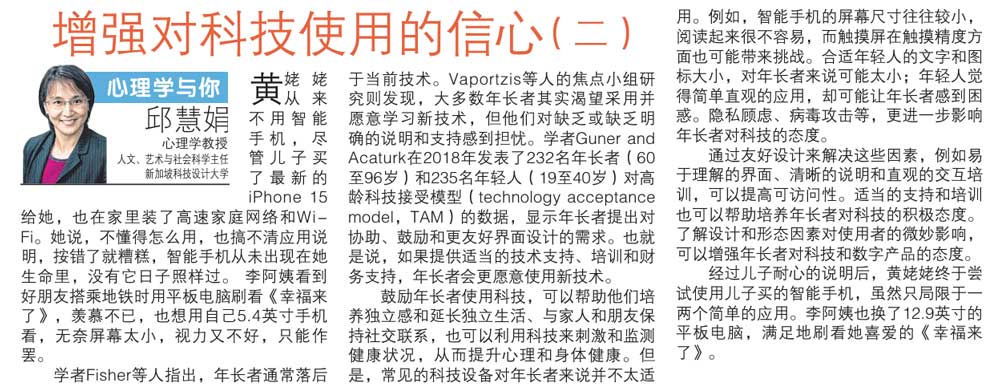Enhance confidence in use of technology
Shin Min Daily News, 13 Jan 2024, 增强对科技使用的信心(二) (translation)
Grandma Huang has never used a smartphone even though her son bought her the latest iPhone 15 and installed high-speed home network and WiFi at home. She said that she did not know how to use it and could not figure out the application instructions. It would be bad if she pressed the wrong button. Smartphones has never appeared in her life and without it, her life would still go on. Aunty Li was envious when she saw her best friend watching "Happiness Comes" on her tablet computer while riding the train. She also wanted to watch it on her 5.4-inch mobile phone, but the screen was too small, and her eyesight was not good, so she had no choice but to give up.
Researcher Fisher and others point out that older people often lag behind current technology. Vaportzis et al.'s focus group study found that most older adults are actually eager to adopt and willing to learn new technologies, but they are concerned about lacking or the lack of clear instructions and support. In 2018, researcher Gunerand Acaturk published data on the technology acceptance model (TAM) of 232 older people (60 to 96 years old) and 235 young people (19 to 40 years old), showing that older people raised concerns about the need for assistance, encouragement and more user-friendly interface design. That is, older adults will be more willing to use new technologies if appropriate technical support, training, and financial support are provided.
Encouraging older adults to use technology can help them develop a sense of independence and extend their independent lives, stay socially connected with family and friends. They can also use technology to stimulate and monitor health conditions to improve mental and physical health. However, common technology devices do not work so well for seniors. For example, smartphone screens tend to be smaller in size, making them difficult to read, while touch screens can also pose a challenge in terms of touch accuracy. Text and icon sizes that are suitable for young people may be too small for seniors; applications that young people find simple and intuitive may confuse seniors. Privacy concerns, virus attacks, etc. further affect the elderly's attitude towards technology.
Addressing these factors through friendly design, such as easy-to-understand interfaces, clear instructions, and intuitive interactive training, can improve accessibility. Appropriate support and training can also help foster positive attitudes toward technology in older adults. Understanding the subtle impact of design and form factors on users can enhance older adults’ attitudes toward technology and digital products.
After her son’s patient explanation, Grandma Huang finally tried to use the smartphone her son bought, although it was limited to one or two simple applications. Aunty Li also switched to a 12.9-inch tablet and was content to watch her favorite "Happiness Comes".
